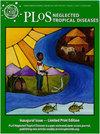口服巴卡巴果汁导致南美锥虫病爆发:卡洛斯-恰加斯发现恰加斯病一个世纪后,这种疾病仍难以控制
IF 3.4
2区 医学
Q1 Medicine
引用次数: 0
摘要
背景 口服传播的急性南美锥虫病(ACD)主要影响热带和亚热带地区的低能见度和低收入人群。即使在发现南美锥虫病 100 多年后,管理南美锥虫病仍然是一项挑战。它向非流行地区的传播使其成为一个全球性的健康问题。这项工作旨在展示在处理实际情况时遇到的困难。方法和研究结果 本报告研究了巴西马拉尼昂州佩德罗-多罗萨里奥市因摄入巴卡巴果汁经口腔传播而爆发的 39 例 ACD 病例。我们进行了临床和流行病学调查,包括昆虫学搜索。诊断标准包括外周血涂片(PBS)阳性、IgG血清转换和IgG滴度增加两倍(实验室标准);以及临床发现、流行病学接触和至少一次IgG检测阳性(临床流行病学标准)。对 33 份样本进行了室内常规聚合酶链反应 (PCR)。所有患者均接受了苯并咪唑治疗。4.5 年后,对 26 人的 IgG 水平进行了重新评估。平均年龄为 33.6 岁,无性别差异。平均潜伏期为 13.8 天,从症状出现到接受治疗的平均间隔时间为 16.6 天。最常见的症状是发烧和淋巴结病(90%)。诊断成功率为 66.6%(实验室标准)、23%(临床流行病学标准)和 10.2%(尽管检测结果为阴性,但临床高度怀疑)。检测阳性率分别为 69.7%(PBS)、91.4%(血清学)和 100%(PCR)。没有死亡病例。34.6%的病例实现了血清学治愈,15.3%的病例 IgG 滴度下降。结论和意义 我们在管理 ACD 的过程中遇到了一些障碍,包括人群的脆弱性、对过时诊断技术的依赖、缺乏标准化的分子生物学方法以及治疗方案有限。本报告强调了快速监测和早期治疗对预防死亡的重要性。我们建议将常规 PCR 纳入标准化诊断程序。本文章由计算机程序翻译,如有差异,请以英文原文为准。
Oral Chagas disease outbreak by bacaba juice ingestion: A century after Carlos Chagas’ discovery, the disease is still hard to manage
Background Orally transmitted acute Chagas disease (ACD) primarily affects low-visibility and low-income individuals in tropical and subtropical zones. Managing ACD remains challenging even after more than 100 years of its discovery. Its spread to non-endemic areas has made it a global health issue. The aim of this work is to demonstrate the difficulties encountered in handling a real-life situation. Methodology and findings This report examines an outbreak of 39 cases of ACD due to oral transmission by bacaba juice ingestion that occurred in Pedro do Rosário, Maranhão, Brazil. A clinical and epidemiological investigation, including an entomological search, was conducted. Diagnosis criteria included positive peripheral blood smear (PBS), seroconversion of IgG, and a two-fold increase in IgG titer (laboratory criteria); and clinical findings, epidemiological exposure, and at least one positive IgG test (clinical-epidemiological criteria). In-house conventional polymerase chain reaction (PCR) was performed on 33 samples. All patients were treated with benznidazole. After 4.5 years, IgG levels were reassessed in 26 individuals. The mean age was 33.6 years, with no gender difference. The mean incubation period was 13.8 days, and the mean between symptom onset and treatment was 16.6 days. The most common symptoms were fever and lymphadenopathy (90%). Diagnostic success rates were 66.6% (laboratory criteria), 23% (clinical-epidemiological criteria), and 10.2% (high clinical suspicion despite negative tests). Test positivity rates were 69.7% (PBS), 91.4% (serology), and 100% (PCR). There were no deaths. Serological cure was achieved in 34.6% of cases, and IgG titers decreased in 15.3%. Conclusions and significance We encountered several barriers in managing ACD, including population vulnerability, reliance on outdated diagnostic techniques, lack of standardized molecular biology methods, and limited therapeutic options. This report underscores the importance of rapid surveillance and early treatment to prevent fatalities. We recommend the standardization of conventional PCR in diagnostic routines.
求助全文
通过发布文献求助,成功后即可免费获取论文全文。
去求助
来源期刊

PLoS Neglected Tropical Diseases
Medicine-Infectious Diseases
CiteScore
7.40
自引率
10.50%
发文量
723
审稿时长
2-3 weeks
期刊介绍:
PLOS Neglected Tropical Diseases publishes research devoted to the pathology, epidemiology, prevention, treatment and control of the neglected tropical diseases (NTDs), as well as relevant public policy.
The NTDs are defined as a group of poverty-promoting chronic infectious diseases, which primarily occur in rural areas and poor urban areas of low-income and middle-income countries. Their impact on child health and development, pregnancy, and worker productivity, as well as their stigmatizing features limit economic stability.
All aspects of these diseases are considered, including:
Pathogenesis
Clinical features
Pharmacology and treatment
Diagnosis
Epidemiology
Vector biology
Vaccinology and prevention
Demographic, ecological and social determinants
Public health and policy aspects (including cost-effectiveness analyses).
 求助内容:
求助内容: 应助结果提醒方式:
应助结果提醒方式:


